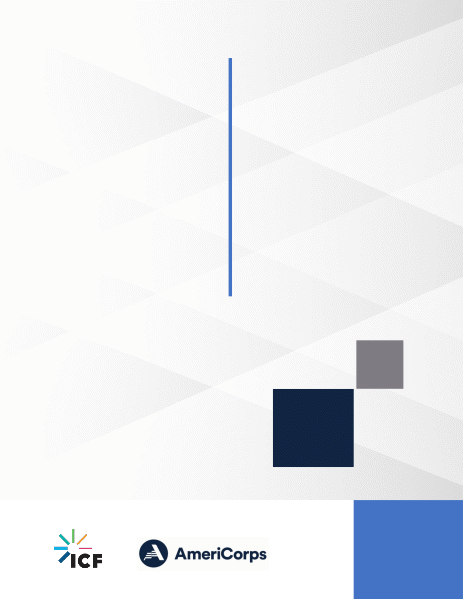20200716 life cycle evaluation ORC SSB
20200716 life cycle evaluation ORC SSB.docx
AmeriCorps Program Life Cycle Evaluation—Opioid Recovery Coach Model Bundled Evaluation
OMB: 3045-0194

Submitted to: Washington, DC 20024 Submitted by:
9300 Lee Highway Fairfax, VA 22031
May 3, 2021
Supporting Statement for
Paperwork Peer
Recovery Coach Model Bundled Evaluation Part
B. Collection of Information 

AmeriCorps
250 E. St., SW
ICF Incorporated, LLC
https://www.icf.com
Reduction Act Submissions
Employing Statistical Methods
The beneficiary survey will be a census of the universe of individuals served by opioid recovery coaches (treatment) and those at the same site receiving opioid use treatment but who are not served by peer recovery coaches (comparison).
B.1. Respondent Universe
The universe of projects to be included in this data collection is shown in Exhibit B-1. Since the full universe of projects will be included, no statistical sampling methods will be implemented.
Exhibit B-1. Estimated size of universe to be sampled
Population |
Universe: site/individual |
Sample: site/individual |
Beneficiary Treatment |
15/500 |
15/500 |
Beneficiary Comparison |
15/500 |
15/500 |
B.2. Statistical Methodology
B.2.1. Statistical Methodology for Stratification and Sample Selection
For the beneficiary survey, we will include all individuals served by opioid recovery coaches (~500) and similar individuals receiving opioid recovery treatment but not served by opioid recovery coaches (~500) from the same 15 projects that received AmeriCorps grants in 2022-2023. These projects were identified by ICF through an extensive grant application review.
B.2.2. Estimation Procedure
We will first generate descriptive statistics for each item in beneficiary surveys. Descriptive analyses will help to answer questions about program design, implementation, and the resulting outcomes. In addition, we will also look at changes in these outcomes between baseline and 12-month follow-up.
Comparative analyses will examine the extent to which observed differences in outcomes can be attributed to the opioid peer recovery coach model. We propose taking a regression approach that examines the relationship between program status and relevant outcomes while controlling for other confounding variables. Specifically, we anticipate using two-level hierarchical linear modeling (HLM). HLM produces more accurate results than ordinary least square models by modeling the hierarchical structure in the organization (e.g., individuals nested within sites), correcting for aggregation bias, misestimated precision, and the unit of analysis problem. At level 1, individual outcomes will be predicted as a function of program status (treatment versus comparison) and other demographic and academic characteristics. At level 2, site characteristics will be used as covariates. The differences between the treatment and comparison groups will be assessed in terms of 1) p-values, or the probability that the observed differences could be due to chance, and 2) effect sizes, which measure the magnitude of the differences. Results from the comparative analyses will provide evidence of whether the opioid peer recovery coach model made a difference in institutional and individual outcomes.
B.2.3. Degree of Accuracy Needed for the Purpose Described in the Jurisdiction
Most of the statistics produced will be descriptive. However, in cases where group differences are examined statistically, we plan to set the α at 0.05 level as a significance threshold.
B.2.4. Unusual Problems Requiring Specialized Sampling Procedures
No unusual problems are anticipated.
B.2.5. Use of Periodic (Less Frequent Than Annual) Data Collection Cycles
As described previously, the beneficiary surveys will be administered for both treatment and comparison groups at the baseline and 12-month follow-up. The evaluation technical assistance outcome survey will be administered for the participants at the baseline before they attend the workshops, and at 12-month follow-up when they complete all the sessions.
B.3. Methods to Maximize Response Rates and Deal With Issues of Non-response
For beneficiary surveys, the list of treatment and comparison groups will be provided to ICF by participating grantees; the list will include names, treatment status, and emails. Perspective respondents will receive several types of assistance to ensure that they understand the importance of the data collection effort, their responsibilities for providing the data, and the technical aspects of data submission.
Before each data collection, participating
grantees will email a pre-notification and encourage all perspective
respondents to participate in the survey. Within one week of the
pre-notification, ICF will follow up with a recruitment email
providing a link to the
15-minute survey URL programmed by
Qualtrics. Before responding to the survey, participants will be
asked to read the consent form describing the purpose of the survey.
The form assures that participation is voluntary and that responses
are confidential, and provides contact information for the study lead
and Institutional Review Board (IRB). After providing consent,
participants will proceed to answer the survey. Respondents will be
given one week to respond to the survey. The research team will
continue to monitor the completion. We will send two reminders on a
weekly basis to non-respondents. Respondents will be sent a “thank
you” for their participation.
Based on a similar bundle evaluation on opportunity youth funded by AmeriCorps, we expect that 45% of those in the treatment group responding to the baseline surveys will respond to the follow-up survey, and 25% of the comparison group will do so. A non-response bias analysis will be conducted using auxiliary data, including demographics, from the sampling frame. Any strong predictors of non-response may be candidates for building a response propensity model, which could then be incorporated into the non-response adjustment as part of the survey weights for this group.
B.4. Tests of Procedures and Methods
The survey design, data collection procedure, and analysis approaches have been reviewed and approved by the AmeriCorps Office of Research and Evaluation. In addition, as described in Section A.8., the research plan has been reviewed by an external Technical Working Group consisting of six nationally recognized experts in evaluation of national services and a Field Working Group consisting of six program leaders in AmeriCorps. Finally, the survey instrument, consent form, and recruitment letter were reviewed and approved by ICF IRB.
B.5. Names and Telephone Numbers of Individuals Consulted
Agency Unit
Amy Borgstrom, Associate Director of Policy, COO Immediate Office, AmeriCorps, 202-606-6930
Mary Hyde, Director, Office of Research and Evaluation, AmeriCorps,
202-606-6834Lily Zandniapour, Research & Evaluation Manager, Office of Research and Evaluation, AmeriCorps, 202-606-6939
Jehyra M. Asencio-Yace, Research Analyst, Office of Research and Evaluation, AmeriCorps, 202-956-9736
Contractor
Xiaodong Zhang, Project Director, ICF, 703-251-0883
Jing Jun, Senior Analyst, ICF, 703-225-2328
| File Type | application/vnd.openxmlformats-officedocument.wordprocessingml.document |
| Author | Holbrook, Brynn |
| File Modified | 0000-00-00 |
| File Created | 2021-07-29 |
© 2025 OMB.report | Privacy Policy